การออกแบบและประเมินองค์ประกอบของแอปพลิเคชันปรับเปลี่ยนพฤติกรรมเสี่ยงของโรคออฟฟิศซินโดรม การออกแบบและประเมินองค์ประกอบของแอปพลิเคชันปรับเปลี่ยนพฤติกรรมเสี่ยงของโรคออฟฟิศซินโดรม
Main Article Content
บทคัดย่อ
This study is designed to create and evaluate the components of a “Prototype application for adjusting risky behavior of office syndrome” The study employs a mixed approach incorporating gamification concepts in the design. The objectives are: 1) Study the components of an application to adjust risky behavior of office syndrome using gamification. 2) Study the need for an application to change users' risky behavior. The sample group includes support personnel. Faculty of Information Science, 78 people, which were obtained through purposive selection., and 3) to assess the suitability of the prototype application's components. The sample consists of 78 support staff members from the Faculty of Information Science, selected purposively. The research tools include: 1) a component analysis table, 2) a user requirements questionnaire, and 3) a suitability evaluation form for the prototype application components. Data analysis is conducted using percentages, means, and standard deviations.
The results show that: 1) Gamification functions incorporated into the design are one of the components of an application that uses gamification. establishing use goals (Goal), assessing behavior levels (Level), determining rewards (Reward), establishing app rules (Rules), rating competitors (Competition), timing of notifications (Time), and response (Feedback). The button shape in the design is rounded, and the color tone is pleasing to the sight. The program is easy to navigate thanks to its layout. 2) The 78 target group members (32 males, representing 41%, and 46 females, representing 59%) expressed a 100% demand for the behavioral adjustment application. 3) The quality assessment by 5 application experts revealed that the prototype application's quality is at a very good level (𝑥̅ = 4.56, S.D. = 0.50). The results of evaluating the suitability of this component Can be used to design and develop applications to change risk behaviors of office syndrome. This research shows the use of gamification elements. That has the effect of creating motivation and stimulating users to be able to change the risky behavior of Office Syndrome in the future.
Article Details
References
ปริญญาภรณ์ ธนะบุญปวง, จิริยา อินทนา, นงนุช วงศ์สว่าง, และชลธิชา บุญศิร. (2024). การประยุกต์ใช้ทฤษฎีการกระทำด้วย
เหตุผลในการปรับเปลี่ยนพฤติกรรมสุขภาพตามบทบาทของพยาบาลเวชปฏิบัติชุมชน. วารสารวิจัยเพื่อการส่งเสริมสุขภาพและคุณภาพชีวิต, 4(1), 83-94.
Deterding, S., Dixon, D., Khaled, R., & Nacke, L. (2020). From game design elements to gamefulness: defining
“gamification”. In Proceedings of the 15th international academic MindTrek conference: Envisioning future
media environments (pp. 9-15).
Zichermann, G., & Cunningham, C. (2021). Gamification by Design: Implementing Game Mechanics in Web and
Mobile Apps. O'Reilly Media. pp. 139
Fitz-Walter, Z., Denny, S., & Mullan, B. (2022). Gamification and health behavior change: A systematic review.
Health Psychology Review, 16(1), 1-23. https://doi.org/10.1080/17437199.2021.1886164
สํานักงานสถิติแห่งชาติ. (2563). การสํารวจการมีการใช้เทคโนโลยีสารสนเทศและการสื่อสารในครัวเรือน พ.ศ. 2564 (ไตรมาส 4).
จุฬาวรรณ วิสภา, วันธณี วิรุฬห์พานิช, & พิสมัย วัฒนสิทธิ์. (2563). ผลของโมบายแอปพลิเคชันการ ควบคุมน้ำหนักต่อพฤติกรรม
การบริโภคอาหาร, กิจกรรมทางกาย, และน้ำหนักตัวในวัยรุ่นที่มีภาวะน้ำหนักเกิน. วารสารพยาบาลตำรวจ, 12(1), 73-85. URL: https://he01.tcithaijo.org/index.php/policenurse/article/view/241961
ภัทรพล นัยจตร. (2555). หลักการปรับพฤติกรรมในเด็ก. ค้นข้อมูล 19 กันยายน 2566, จาก
http://kmlo.crma.ac.th/kmnew/wp-content/uploads/2018/05/km56_17.
อํานาจ วัดจินดา. (2560). การปรับพฤติกรรม Behavior Modification
https://hrcenter.co.th/file/columns/hr_f_20170512_154857.pdf
Saitong, P. (2022). Designing, developing, and efficiency evaluation of a smartphone application for blood
donation.Ingénierie des Systèmes d’Information, Vol. 27, No. 4, pp. 565-576.
https://doi.org/10.18280/isi.270406
ภาวินี แสงจันทร์, & ชวนชม ธนานิธิศักดิ์. (2561). การพัฒนาแอปพลิเคชันสําหรับให้บริการเลิกบุหรี่โดยเภสัชกรชุมชน. ศรี
นครินทร์เวชสาร,33(2), 169.
มานิต ตันเจริญ. (2560). ศึกษาพฤติกรรมการบริโภคผักให้ปลอดภัยจากสารพิษของประชาชน ศึกษากรณีตําบลดอนเจดีย์ อําเภอ
พนมทวน จังหวัดกาญจนบุรี. วารสารมหาวิทยาลัยราชภัฎกาญจนบุรี,11(1), 36-45
Yonas Deressa Guracho. (2023). Smartphone application use patterns for mental health disorders: A systematic
literature review and meta-analysis. International Journal of Medical Informatics,179. https://doi.org/10.1016/j.ijmedinf.2023.105217
สถาพร จะนุ. (2565). การพัฒนารูปแบบการเรียนออนไลน์แบบสร้างความสัมพันธ์ตามแนวคิดเกมมิฟิเคชันเพื่อเสริมสร้างแรงจูงใจ
ใฝ่สัมฤทธิ์และทักษะการทํางานเป็นทีมในการเขียนโปรแกรมของนักศึกษาระดับปริญญาตรี มหาวิทยาลัยราชภัฏ. วารสารมหาวิทยาลัยราชภัฏยะลา, 26 (1), 99-108.
ชินวัจน์ งามวรรณากร. (2562). การพัฒนาแอปพลิเคชันสื่อการเรียนรู้บนอุปกรณ์เคลื่อนที่ เรื่อง ภาษาอังกฤษสำหรับนัก
สารสนเทศ. รายงานวิจัยคณะมนุษยศาสตร์และสังคมศาสตร์ มหาวิทยาลัยราชภัฏยะลา.
https://wb.yru.ac.th/xmlui/handle/yru/5356
นิจกานต์ หนูอุไร. (2564). พฤติกรรมการใช้ประโยชน์และความพึงพอใจจากแอปพลิเคชันไลน์ (วิทยานิพนธ์ปริญญามหาบัณฑิต).
มหาวิทยาลัยทักษิณสงขลา, สงขลา.วารสารมนุษยศาสตร์และสังคมศาสตร์, 3(1), 151-174
ธานิล ม่วงพูล และอวยไชย อินทรสมบัติ. (2559). การทดสอบประสิทธิภาพแอปพลิเคชันสื่อการสอนศัพท์ภาษาอังกฤษ สำหรับ
นักเรียนประถมศึกษาปีที่ 1 บนระบบปฏิบัติการแอนดรอยด์, คณะวิทยาศาสตร์และเทคโนโลยี. ในการประชุมวิชาการและเสนอผลงานวิจัยระดับชาติ ครั้งที่ 3 ก้าวสู่ทศวรรษที่2 : บูรณาการงานวิจัย ให้องค์ความรู้ สู่ความยั่งยืน. นครราชสีมา: วิทยาลัยนครราชสีมา. 31-37.
อัจฉรา โพชะโน. (2566). ปัจจัยที่มีผลต่อพฤติกรรมเสี่ยงต่อโรคออฟฟิศซินโดรมในวัยทํางาน ของบุคลากรสถาบันพัฒนาสุขภาวะ
เขตเมือง. วารสารศูนย์อนามัยที่ 9,17(3), 882.

